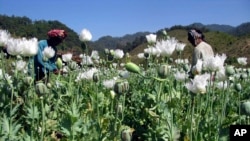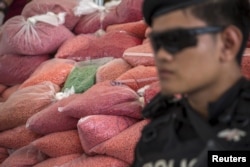Southeast Asia's "Golden Triangle" is still exporting very high volumes of illicit drugs according to a new U.N. agency report.
Researchers say the precursor chemicals needed to manufacture opiates and methamphetamines are streaming in to the region unabated and the problem is forecast to get worse as Southeast Asia's economic integration continues.
"As you open the borders more, as you push trade volumes ever higher, you're increasing opportunity for illicit flows to move more quickly because illegal flows tend to mirror or use or abuse legal trade flows," according to Jeremy Douglas, the regional representative for Southeast Asia and the Pacific of the U.N. Office on Drugs and Crime (UNODC).
The significant organized crime threat involves not only narcotics but also human trafficking and wildlife smuggling, according to the report released Thursday by UNODC, which focuses on fighting illicit drugs and international crime.
Revenue of at least $100 billion
The UNODC report contains what it calls a “conservative estimate” of annual revenue from organized crime in the region at $100 billion. That is more than the combined gross domestic product of several Southeast Asian nations.
Even as the ten-member states of the Association of Southeast Asian Nations (ASEAN) spend trillion of dollars for new air and sea ports, railways and highways, researchers say other important areas are being neglected.
“We see announcement after announcement after announcement of these major mega-projects to support regional integration of the region and this region with its neighboring regions, with China, with India,” Douglas told VOA. “What we aren't seeing is a similar investment in either political or real capital by the governments of this region, yet, in their security agenda in an integrated way.”
In the meantime more criminals are moving out of China and into ASEAN as Chinese law enforcement increases crackdowns. That has made ASEAN an attractive relocation venue for Chinese gangs as regulations are weaker, authorities more lax and pliable. There is also the added benefit of lower production costs.
Remote locations in Southeast Asia where the reach of central governments are tenuous and borders are porous have allowed organized crime to flourish for decades.
Hill tribe refugees by the early 20th century turned the hilly Golden Triangle region, encompassing parts of Laos, Myanmar and Thailand, into a major center for opium production.
Scope is growing
The new UNODC report notes the boundaries and scope of the traditional illegal drug manufacturing are growing. There is increasing trade these days between India and ASEAN in not only illicit drugs but also precursor chemicals and counterfeit medicines.
The precursors for the production of heroin and synthetic drugs are also trafficked into Southeast Asia from China.
Less than two percent of the 500 million containers annually that are shipped through the region’s waters are inspected, facilitating the trade in illicit drugs and counterfeit products.
ASEAN nations are not taking the threat seriously enough and more real-time sharing of information and intelligence on criminal activities is needed, according to analysts. Also required, they say, is more effective handling of mutual legal assistance requests.
UNODC officials say discussion is needed among regional leaders for a security agenda to support the region’s growing prosperity.
“If they don't have that candid discussion the sense is that in a few years from now we are going to have created some problems for the region through very well-intentioned trade and infrastructure investments,” Douglas warned.









